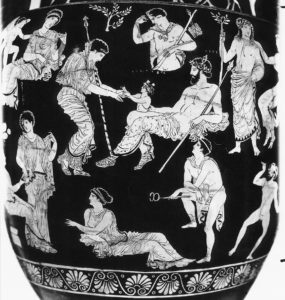κατὰ δὲ τὸν χρόνον τὸν καθήκοντα Διόνυσον γεννᾷ Ζεὺς λύσας τὰ ῥάμματα, καὶ δίδωσιν Ἑρμῇ. ὁ δὲ κομίζει πρὸς Ἰνὼ καὶ Ἀθάμαντα καὶ πείθει τρέφειν ὡς κόρην. ἀγανακτήσασα δὲ Ἥρα μανίαν αὐτοῖς ἐνέβαλε, καὶ Ἀθάμας μὲν τὸν πρεσβύτερον παῖδα Λέαρχον ὡς ἔλαφον θηρεύσας ἀπέκτεινεν, Ἰνὼ δὲ τὸν Μελικέρτην εἰς πεπυρωμένον λέβητα ῥίψασα, εἶτα βαστάσασα μετὰ νεκροῦ τοῦ παιδὸς ἥλατο κατὰ βυθοῦ. καὶ Λευκοθέα μὲν αὐτὴν καλεῖται, Παλαίμων δὲ ὁ παῖς, οὕτως ὀνομασθέντες ὑπὸ τῶν πλεόντων: τοῖς χειμαζομένοις γὰρ βοηθοῦσιν. ἐτέθη δὲ ἐπὶ Μελικέρτῃ ὁ ἀγὼν τῶν Ἰσθμίων, Σισύφου θέντος. Διόνυσον δὲ Ζεὺς εἰς ἔριφον ἀλλάξας τὸν Ἥρας θυμὸν ἔκλεψε, καὶ λαβὼν αὐτὸν Ἑρμῆς πρὸς νύμφας ἐκόμισεν ἐν Νύσῃ κατοικούσας τῆς Ἀσίας, ἃς ὕστερον Ζεὺς καταστερίσας ὠνόμασεν Ὑάδας.
- Map
- Pre Reading
- Post Reading
- Culture Essay
Read the culture essay, “Ino and Melicertes.”
Transformations abound in Part C of Apollodorus’ “Semele and Ino”: gender roles are reversed, children are likened to animals, names change. In complete Greek sentences, list all the transformations that take place in this section. Then brainstorm with a partner why each one may have taken place.
Review: Participles-Post-reading-Semele&Ino.
Read the culture essay “Ino and Melicertes: Filling in the Missing Blanks.”

